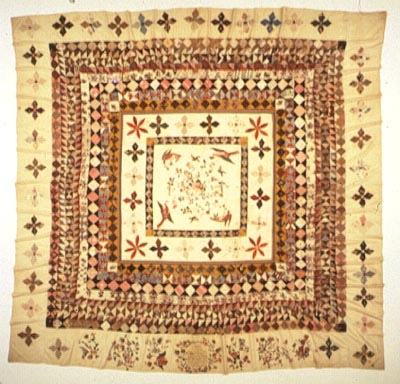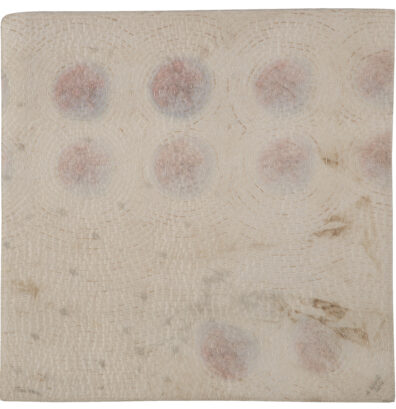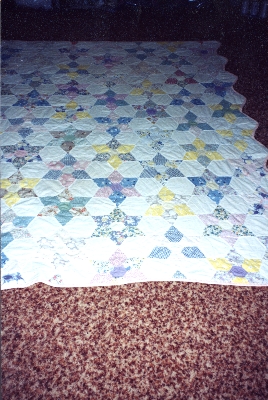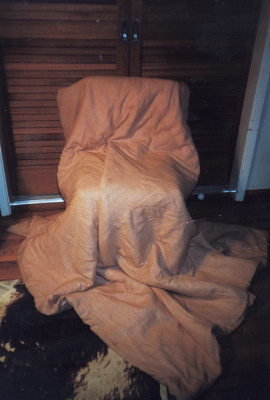History
Convict women made this quilt en route to Australia in 1841, on board the Rajah. The ship left Woolwich on 5th April and arrived in Hobart 19th July with 179 women prisoners. There were possibly twenty-nine convict women on board the ship who worked the quilt.
The fabrication of the Rajah quilt was organised by prison reformer Elizabeth Fry and the 'British Ladies Society for the Reformation of Female Prisoners' who were all members of the Quaker religious order. A woman listed as a free passenger of the 'Rajah' Miss Kezia Hayter is conjectured to have been the supervisor of the creation of the quilt and the needleworker of the most skill in its fabrication; she probably did the inscription panel. One of the border bands carries an inscription in very fine cross stitch (18 stitches/cm). The inscription reads: 'TO THE LADIES Of the Convict ship committee. This quilt worked by the Convict of the ship Rajah during their voyage to Van Diemans Land is presented as a testimony of the gratitude with which they remember their exertions for their welfare while in England and during their passage and also of proof that they have not neglected the Ladies kind admonitions of being industrious * June * 1841 *'.
Extensive information is held at the NGA on the details of the voyage and the women who were transported to Australia upon the Rajah. Little is known of the past owners of the quilt. It is believed that the quilt was presented to a government official soon after the Rajah's arrival. In 1987 the quilt was discovered in a private collection in Scotland. In 1989 it was purchased and donated to the National Gallery of Australia by Les Hollings and the Australian Textile Fund" [NGA]
Description
"The Rajah 'quilt' is a patchwork and appliquéd bed cover or coverlet. It is in pieced medallion or framed style: a popular design style for quilts in the British Isles in the mid 1800's. There is a central field of white cotton decorated with appliquéd (in broderie perse) chintz birds and floral motifs. This central field is framed by twelve bands or strips of patchwork printed cotton. The quilt is finished at the outer edge by white cotton decorated with appliquéd daisies on three sides and inscription in cross stitch surrounded by floral chintz attached with broderie perse on the fourth side. All fabrics used in the Rajah quilt are cotton with the exception of small amounts of linen and silk threads. The quilt shows evidence of being produced by many hands." [NGA] The quilt is not padded or lined.
3372 x 3250mm




My GGGgm was aboard the Rajah and may have contributed to the making of this unique quilt, so it is my life-long wish to see the Rajah quilt displayed to the public because it is one of Australia’s national treasures. What a great tragedy for this quilt to be locked away by the NGA in an era when preservation methods are now so sophisticated using emerging technologies. When I was in China, I viewed 2000 year old tapestries which were encased in glass away from natural light, without any issue. Please advocate to have the Rajah quilt displayed for the public’s enjoyment ! Frances Cudmore (for Grace Stevens).
I just finished reading a book, Dangerous Women, by Hope Adams, about this quilt. I saw the book on a shelf at our local library, picked it up, and read the inside flap. It intrigued me and luckily, I decided to borrow it.
What an interesting story, I couldn’t put it down. Thank goodness, Frances Cudmore was able to secure the quilt and have it displayed for all to see. Thank you.
Nina
I just finished reading “Dangerous Women”–what a well-written and amazing book! I am thankful to be able to see a picture. Thx
My 4 time Great Grandmother Sarah Pindar who was 59 on embarking from Milbank Penitentiary was on the Rajah. I would love to bring my children and grandchildren to see this work. Please make it available to the public to see.
Hi Rita, you can contact the National Gallery of Australia and arrange for yourself, children and grandchildren to view the quilt. More information can be found here on their website: https://nga.gov.au/visit/collection-study-room/